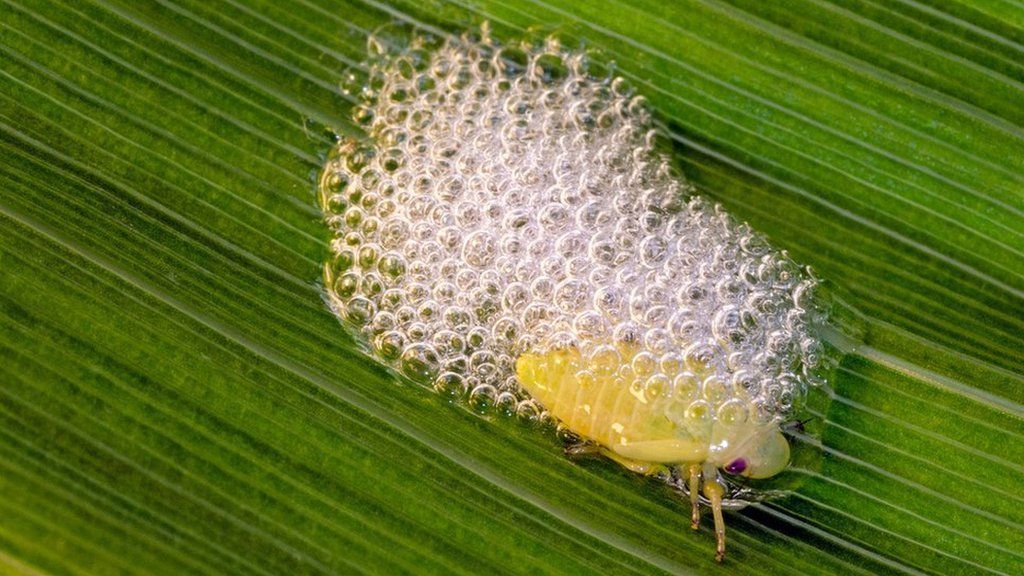Revealed: The secret life of the spittlebug
- Published

Citizen scientists have provided a wealth of new data on a curious insect that makes blobs of spittle on plants.
More than 11,000 sightings of the spittlebug, or froghopper, have been recorded across the UK, with the south of England proving a stronghold.
The information will be used to prepare for the threat of the plant disease, Xylella.
The spittlebug is a vector of the disease, which is present in several EU countries outside the UK.
Scientists have appealed for thousands of volunteers to record spittle and spittlebugs in gardens and green spaces. This will help them fight any future outbreak by modelling how the disease might spread.
From the information submitted over the past month, plant and insect experts have found that the south of England is proving a hotbed for spittlebug sightings.
The top five areas in terms of numbers of records submitted are Surrey, South Hampshire, East Sussex, Middlesex and the south of Devon.
The preliminary data shows that the vast majority (85%) of insect records are for the common or meadow froghopper (Philaenus spumarius).
The insect has been recorded living on over 400 plant species and 81% of records have been submitted from private gardens.
Scientists want your help tracking spittlebugs.
The top hosts are:
- Lavender - 40% of records
- Rosemary - 12% of records
- Rose - 4% of records
- Fuchsia - 3% of records
- Grass vetchling - 2% of records.
Spittle is produced when spittlebug nymphs secrete plant juices. Spittle is coming to an end, as the newly-hatched spittlebugs mature into adults, but scientists are keen to hear of further sightings.
They say spittlebugs are not plant pests in their own right - and part of our native fauna - and people should not harm them in any way.
"Xylella is not in the country and we would wish people to leave these insects well alone, but to record where the spittle has been found and on what plant species," said Gerard Clover, head of plant health at the Royal Horticultural Society (RHS).
Other stories you might like:
The RHS is also warning holidaymakers not to bring plants in from abroad that may be harbouring the Xylella bacterium.
Actress Dame Helen Mirren is supporting the call, saying she has witnessed first-hand the destruction of centuries-old olive trees in Puglia, Italy.
"Preventing Xylella's spread is a priority and something that UK holidaymakers can support by simply avoiding bringing plants back from abroad that may be harbouring the bacterium," she said.
"Our gardens and green spaces are vital for people and the planet and a failure to act could mean the landscapes that define us could be irreversibly changed."
What is Xylella?
Xylella fastidiosa arrived in Europe six years ago, devastating olive groves in southern Italy and spreading to other countries in the EU, including parts of France and Spain.
The disease is caused by a bacterium which is moved from one plant to another by plant-sucking insects such as the spittlebug.
According to experts, Xylella is one of the most dangerous pathogens worldwide.
If found in the UK, all host plants within 100m would need to be destroyed and there would be immediate movement restrictions on some plants within a 5km radius for up to five years.
Facts about the spittlebug
- Small, sap-sucking insects which are also known as froghoppers
- Can be found in UK gardens, meadows, grasslands and woodlands from April to late June
- The most common species in the UK is the common or meadow spittlebug (Philaenus spumarius). Adults are 0.5cm long and vary in pattern and colour from pale brown to black and can jump many times their body length
- The red-and-black spittlebug hatches out on the roots of plants, rather than in blobs of spittle on plant stems
- There are ten species of spittlebug in the UK and the young - called nymphs - all produce whitish, frothy blobs of spittle on leaves and branches.
Source: RHS.
How do I take part in the survey?
The spittlebug citizen science project is part of a number of research initiatives to understand more about how the different species of froghopper are distributed across the country, including their density, abundance, and which plant species they feed on.
You can help by reporting sightings of spittlebugs in gardens and green spaces here.
Further information about the survey and the insects can be found here.
The citizen science project is part of a wider project, called BRIGIT, supported by Defra and the Scottish government, to look at UK surveillance and response to Xylella.
Follow Helen on Twitter.